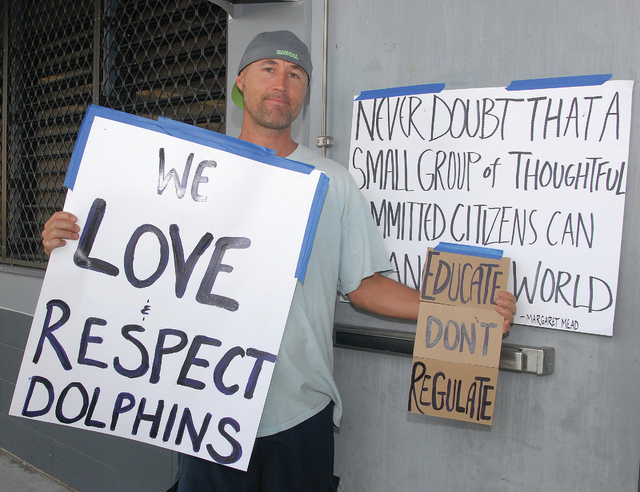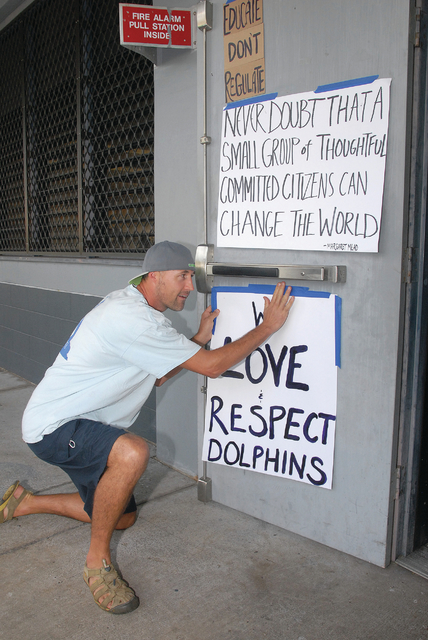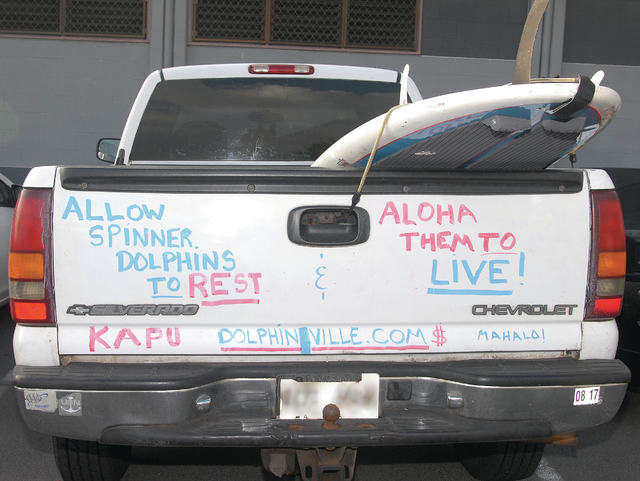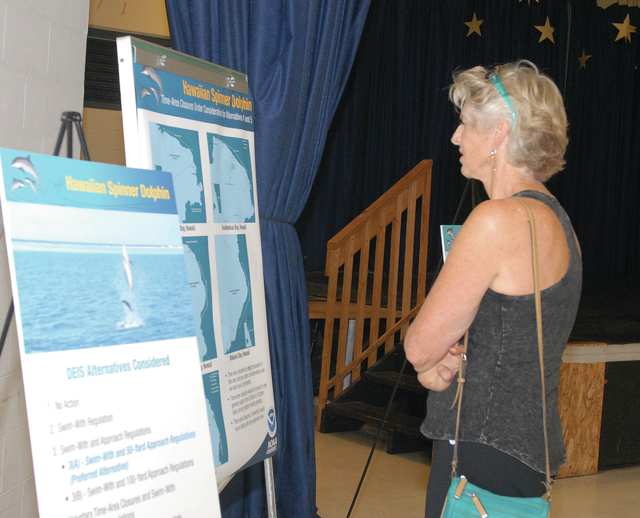KAILUA-KONA — The dolphin debate resumed Thursday night at Kealakehe High School over regulations proposed by the National Oceanic and Atmospheric Administration that would create a 50-yard barrier around Hawaiian spinner dolphins for swimmers and marine vessels, with a few
KAILUA-KONA — The dolphin debate resumed Thursday night at Kealakehe High School over regulations proposed by the National Oceanic and Atmospheric Administration that would create a 50-yard barrier around Hawaiian spinner dolphins for swimmers and marine vessels, with a few specific exceptions.
The practice of swimming with dolphins has created a booming industry in Kona, and is enjoyed by locals and tourists alike. While concerns voiced at the public hearing often touched on environmental impacts and personal rights, the economic questions remained prevalent as many fear the consequences if NOAA’s proposed rule ever goes into effect.
Kirstin Kahaloa, executive director of the Kona-Kohala Chamber of Commerce, said there aren’t exact figures to indicate the amount of money swim-with-dolphin tours pump into the local economy. But she added there is no question businesses in West Hawaii would be adversely affected if the practice was outlawed.
“Our waters are known to be very popular for ocean recreation activities,” she said. “A lot of people travel to the Big Island and Kona for ocean recreation, whether it’s for dolphins or manta rays or just general snorkeling, and we can tell that just by looking out the window every single day. We have several chamber members directly linked to ocean recreation, and at least six off the top of my head that will be severely impacted.”
One business that could feel the brunt of the new rule is Jack’s Diving Locker. Jeff Leicher, owner and operator, took to the microphone Thursday night to express his thoughts on the matter.
He said that while it’s important to make sure the activity is sustainable in the long term, eliminating it entirely would be a mistake. His suggestion was that a permitting process be implemented to control the industry.
“I’m not a scientist, but my gut feeling is that the population is increasing and that the dolphins are getting more interactive and more friendly over time,” Leicher said.
He added that if human interaction with dolphins was the problem NOAA researchers believe it is — due to disruption of mating, nursing and resting activities — the decline in the dolphin population would be more obvious and readily observable to the naked eye.
Instead, he contended, dolphins can be observed engaging in all of those activities by people on dolphin tour boats.
“We would miss those (tourists) if they had to go (elsewhere) to swim with the dolphins,” he said. “And the dolphins here will not be any better off.”
But Jean Higgins, a biologist with NOAA who co-hosted meetings at Konawaena and Kealakehe High Schools on Wednesday and Thursday nights, said economic research conducted at the behest of NOAA shows an entirely different impact on local business — that is to say, not much of an impact at all.
Surveys, questionnaires and interviews have been administered and shown that many customers, if they are aware of the potential negative impact swim-with-dolphin activities can have on the animals, are willing to pay to observe wildlife from a distance.
She added many businesses have also been receptive to the idea.
“We have several businesses that have told us they can switch their business models to a view-only model,” Higgins said.
One business on Oahu, Hawaii Nautical, has been operating in this fashion for more than 15 years.
“Once I found out the research about the dolphins and we started looking at it, it just became apparent this can’t be good for the animal,” said Doug Ewalt, owner of Hawaii Nautical. “It’s difficult to compete with companies that advertise their customers can swim with dolphins. I lose money every day by doing the right thing. And yet, we have still been successful, we have still expanded our fleet, and we still hold many contracts with large hotels.”
Ewalt explained that part of the problem is tour companies feel pressure to create a dynamic experience for their customers because of pressure to produce positive online reviews, the lifeblood of the industry.
He said this pressure is actually reflected in the reviews themselves, which detail inappropriate behavior like chasing dolphins down or circling back around to cut them off — behaviors in which many operators claim not to engage.
The only way to make it in the industry without a strong online presence is to give a lot of commission to concierge desks and drum up business that way, he said.
“Most operators will say they’re not harming the dolphins, just trying to make a living. That’s hogwash,” Ewalt said. “Swim-with companies are so shortsighted, because they’re believing in one or two generations of business. These dolphins, once they’re gone, they’re never coming back. Four years from now, we’re going to throw up our hands and say, ‘Man, we should have done something.’”






